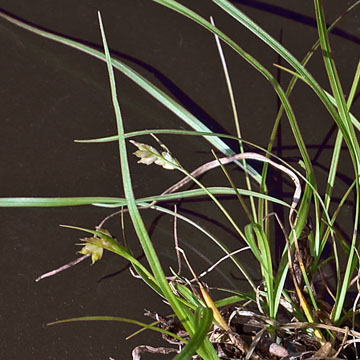

Carex deflexa - (image 1 of 4)
Taxonomy
Family: Cyperaceae
Section Acrocystis
Habitat
Moist to dry open to partly shaded areas and margins of woods and swamps.
Associates
Distribution
Greenland to AK, south in eastern North America to MA, northern NY, northern MI, and northern MN.
Morphology
Perennial from rather short, slender rhizomes; stems loosely cespitose, slender, 10-20 cm, purple-tinged at the base, usually surpassed by the leaves, usually smooth or weakly scabrous distally; leaves soft, thin, 1-3 mm wide; near-basal, slender-pedunculate pistillate spikes usually abundant; staminate spike terminal, 2-5 mm (6-11 mm in the western var. boottii, with similar plants known from the southern Appalachians of GA, NC, and VA), often overtopped by one or more of the 2-4 associated pistillate spikes, the lowest one of these subtended by a green bract 5-20 mm; pistillate scales pale to dark reddish brown with narrow to broad white margins, lance-ovate to oblong, as wide as but shorter than the perigynia; perigynia yellowish green to grayish green, stipitate, 2-3 mm, the body obovoid or pyriform, 2-keeled, finely short-hairy, abruptly contracted to a minutely bidentate beak 0.4-0.8 mm long with apical teeth 0.1-0.2 mm.
Notes
Fruiting mid-May to August
Wetland indicator: NA
Similar to C. umbellata and C. tonsa in that some pistillate spikes are produced from basal nodes in addition to some very close to the staminate spike, but differs in that the rhizomes are slender (vs. stout), and the culms are usually loosely cespitose, arching or spreading, and smooth except near the inflorescence (vs. culms densely cespitose, ascending, and scabrous). It also has smaller perigynia (not more than 3.1 mm long).
References
Gleason, Henry A. and A. Cronquist. 1991. Manual of Vascular Plants of
Northeastern United States and Adjacent Canada. Second Ed.
The New York Botanical Garden. Bronx, NY
|
© Michael Hough 2018 |